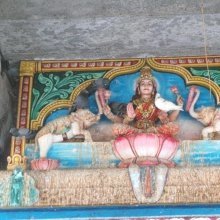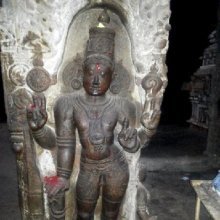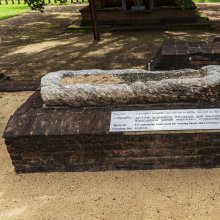Entering: 2 definitions
Introduction:
Entering means something in Hinduism, Sanskrit, the history of ancient India. If you want to know the exact meaning, history, etymology or English translation of this term then check out the descriptions on this page. Add your comment or reference to a book if you want to contribute to this summary article.
Images (photo gallery)
In Hinduism
Yoga (school of philosophy)
Source: ORA: Amanaska (king of all yogas): A Critical Edition and Annotated Translation by Jason BirchEntering (the bodies of others) refers to one of the Yogic powers obtained by those having practices for over five years, according to the Śivayogadīpikā, an ancient Sanskrit text dealing with Yoga possibly corresponding to the Śivayoga quoted in Śivānanda’s Yogacintāmaṇi.—Accordingly, [while describing a sequence of Haṭhayoga practices]: “Thus, by means of this Haṭhayoga which has eight auxiliaries, those [students who are] life-long celibates obtain the Siddhis of the [best of Sages] because of their untiring practice. [...] In the fifth year, he has clairaudience, the Siddhi of speech and [the power to] enter (praveśa) the bodies of other [beings]. Within six [years,] he cannot be pierced by even a thunderbolt, he can move extremely quickly and has clairvoyance. [...]”.

Yoga is originally considered a branch of Hindu philosophy (astika), but both ancient and modern Yoga combine the physical, mental and spiritual. Yoga teaches various physical techniques also known as āsanas (postures), used for various purposes (eg., meditation, contemplation, relaxation).
India history and geography
Source: Singhi Jain Series: Ratnaprabha-suri’s Kuvalayamala-katha (history)Entering (the sea) (to save some drowning relation) represents a scene of human life commonly depicted on the Saṃsāracakra paintings, in ancient India, as mentioned in the Kathās (narrative poems) such as Uddyotanasūri in his 8th-century Kuvalayamālā (a Prakrit Campū, similar to Kāvya poetry).—Page 185.21 f.: Here follows a description of a printed scroll illustrating the Jaina conception of saṃsāracakra. [...] The saṃsāra-cakra illustrated the three worlds of hell, human world and the world of gods. [For example:] A man entering the sea to save some drowning relation; a man stealing others' money; a fisherman catching a haul of fish with his net

The history of India traces the identification of countries, villages, towns and other regions of India, as well as mythology, zoology, royal dynasties, rulers, tribes, local festivities and traditions and regional languages. Ancient India enjoyed religious freedom and encourages the path of Dharma, a concept common to Buddhism, Hinduism, and Jainism.
See also (Relevant definitions)
Query error!
Full-text (+771): Praveshana, Nivesha, Pravesha, Agnipravesha, Nivesana, Antarvigahana, Anuvesha, Vesana, Praveshaka, Vanapravesha, Aveshika, Avatara, Avesha, Anupravesha, Avesana, Apatti, Samavesha, Nimajjathu, Prenkhana, Veshin.
Relevant text
Search found 430 books and stories containing Entering; (plurals include: Enterings). You can also click to the full overview containing English textual excerpts. Below are direct links for the most relevant articles:
The Great Chariot (by Longchenpa)
Part 3 - The path of seeing < [C. The stages of the paths of meditation on this]
1d.2) The Dharma jewel < [Part 1 - The causal refuge]
Part 4 - The purpose of doing three recitations of that ritual < [B. the extensive explanation of arousing bodhicitta]
Vinaya Pitaka (3): Khandhaka (by I. B. Horner)
Abbreviated repetitions on entering a boundary < [4. Invitation (Pavāraṇā)]
Abbreviated repetitions on entering a boundary < [2. Observance (Uposatha)]
Entering the rains in a cow pen, etc. < [3. Rains (Vassa)]
Vinaya (2): The Mahavagga (by T. W. Rhys Davids)
Mahavagga, Khandaka 3, Chapter 2 < [Khandaka 3 - Residence during the Rainy Season]
Mahavagga, Khandaka 3, Chapter 14 < [Khandaka 3 - Residence during the Rainy Season]
Mahavagga, Khandaka 3, Chapter 12 < [Khandaka 3 - Residence during the Rainy Season]
Satapatha-brahmana (by Julius Eggeling)
Kanda XI, adhyaya 4, brahmana 4 < [Eleventh Kanda]
Kanda X, adhyaya 1, brahmana 1 < [Tenth Kanda]
Kanda XI, adhyaya 1, brahmana 7 < [Eleventh Kanda]
Brahma Sutras (Shankaracharya) (by George Thibaut)
III, 1, 4 < [Third Adhyāya, First Pāda]
IV, 4, 15 < [Fourth Adhyāya, Fourth Pāda]
III, 4, 21 < [Third Adhyāya, Fourth Pāda]
Brahma Sutras (Nimbarka commentary) (by Roma Bose)
Brahma-Sūtra 4.4.15 < [Adhikaraṇa 5 - Sūtras 10-16]
Brahma-Sūtra 4.2.8 < [Adhikaraṇa 5 - Sūtras 7-13]
Brahma-Sūtra 1.1.24 < [Adhikaraṇa 9 - Sutra 24]


